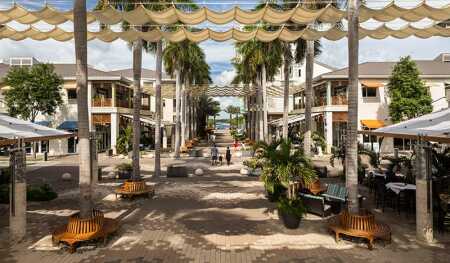Convenience, authenticity, and connectivity were attributes that experts used to characterize trends in master-planned communities during a panel discussion titled “New Dimensions in Master Planning” at the National Association of Real Estate Editors’ recent annual conference in Miami. During the session, panelists tackled questions of how people will work in the future, changing attitudes and processes regarding land planning, and whether or not golf is still part of the resort picture.
Decades ago, a golf course and large clubhouse were centerpieces of any new community, and the location was usually well outside the urban core. Today, new mixed-use communities are just as likely to be urban and are often integral to a city’s revitalization. Panelist David Cobb, a regional director of information provider Metrostudy, noted that during a prior recovery, five master-planned communities accounted for 75 percent of sales in Houston. Today, he points to Miami World Center, a city within a city rising between Miami’s central business district and the design district, as a stimulus bringing new life to the downtown. Touted as “an inspired city of the future,” this development encompassing ten blocks will be one of the largest urban developments in the United States and will offer a mix of office, hospitality, retail, dining, and residential. Amenities are extensive and even include a soccer field.
“Master-planned communities today include thoughtfully integrated land planning that pieces together a variety of uses,” said Andy Carmody, president of the residential division of Crescent Communities, a Charlotte, North Carolina–based developer of residential communities as well as office and industrial space, highlighting changes to the master-planned concept over the last 50 years. And rather than government subsidies, collaboration with permitting and approvals has become more important to development, he explained.
Stewardship—particularly in environmentally sensitive locations, such as the tidal inlets and maritime forests of South Carolina’s low country—is integral to a developer’s vision. At Palmetto Bluff, Crescent Communities works in tandem with a nature conservancy and significantly reduced the number of homes the prior owners had planned to permit. In addition, they educate owners on the benefits of green building. “Luxury buyers are willing to pay for green features to help preserve the land,” Carmody noted. “Overall, buyers are also willing to pay more for green features in their homes if there is some economic return.”
At Camana Bay, a new urbanist community on Grand Cayman Island, developer Dart Enterprises laid a lot of groundwork before beginning construction. Almost ten years before breaking ground on the town, the first project—a nursery to incubate a stockpile of indigenous plants, trees, and shrubs—was initiated, according to Jackie Doak, chief operating officer of Dart Enterprises. Rather than residential real estate, which is often a typical initial phase of resort development, the first building at Camana Bay was a school, followed by a town center and office buildings. Doak said that particular attention was paid to the pedestrian level of the plan. Walkways wind throughout the space. Throughout—in corners, around curves, near an art installation or a water feature—the plan incorporates places to stop and sit, have children play, hold an outdoor meeting, or bring work outside—all opportunities for people to come together and build a sense of community. And those mature trees and shrubs delivered an immediate sense of place. Also, Doak said, “Planning intimate spaces for socializing helps create authentic experiences.”
A well-thought-out pedestrian plan brings various segments of Miami World Center together and illustrates the importance of walkability for even the largest communities.
Millennials are getting a lot of scrutiny today, but a recent survey of preferences of more than 10,000 buyers completed by Crescent showed that values transcend generations. Carmody said, “Every demographic wants a convenient, walkable environment.”
Community and connections are other important values. “Crescent recognizes that community happens when people come together and create relationships and bonds,” said Carmody, noting that they pay a great deal of attention to what he calls “programming in action,” activities that engage residents. Increasingly, new communities plan a year-round calendar of events, often revolving around food, music, and farmers markets. Also, Palmetto Bluff includes sporting amenities such as shooting that are characteristic of the region. “Buyers want authentic and unique today,” he said.
New development can also be a catalyst for change in a region. For example, Camana Bay, which is built to Miami-Dade hurricane standards, is shifting attitudes regarding emergency preparedness on the island and prompting the adaptation of construction techniques that allow a tidal surge to flow through and under a structure. Their secure data center also reduces or eliminates potential storm-related downtime, which means that businesses can be up and running sooner.
Camana Bay is also planning for more millennial buyers and expects to have micro units for sale, Doak said. However, millennials are not living up to some forecasts that projected a majority would be working at home. Cobb said he expected that number to be 30 percent, but in reality it is only 9 percent. Still, Doak believes the concept of “office space” is being revised. Although more office buildings are planned for Camana Bay, the overall plan also takes into account that people are looking for a different type of workplace, she said. “It changes the way we look at office space. People also want to have an office outside of the physical strake. People are craving a different type of workplace, and that changes the way we look at office space.”
Contrary to reports, golf is not dead, but the old model of a golf course and large clubhouse is being rethought. “The economic model of the golf course is broken. Developers have found it to be quite an expense,” said Cobb. Still, Doak and Carmody do not see golf going away for luxury communities. Although the grand clubhouse might be replaced with something smaller and interaction at a club might be different, golf is still part of the experience—but it is not the main focus. Instead, the emphasis has shifted to community, convenience, and connecting.






